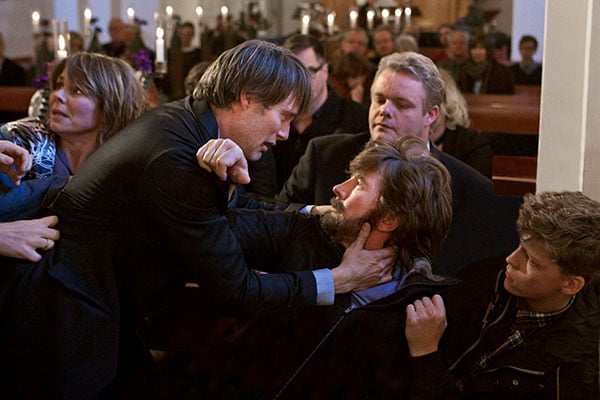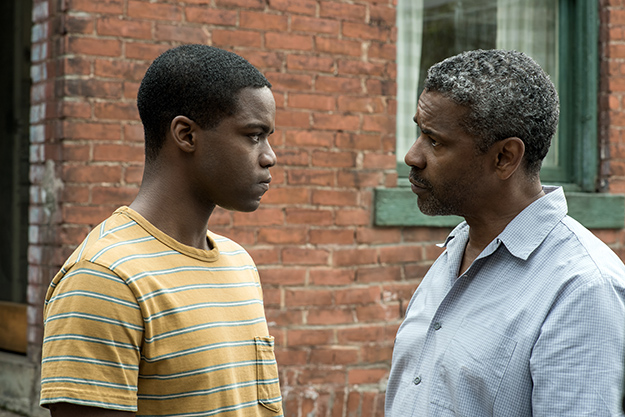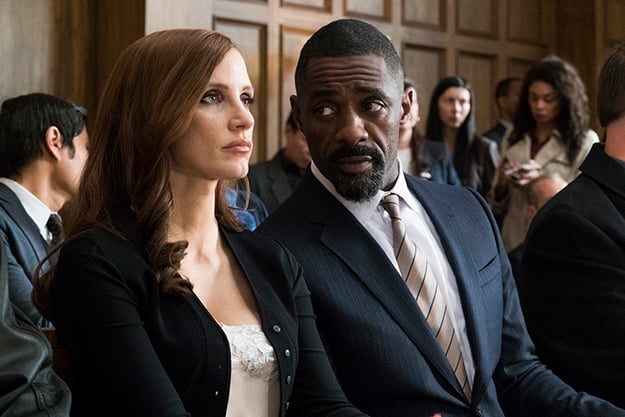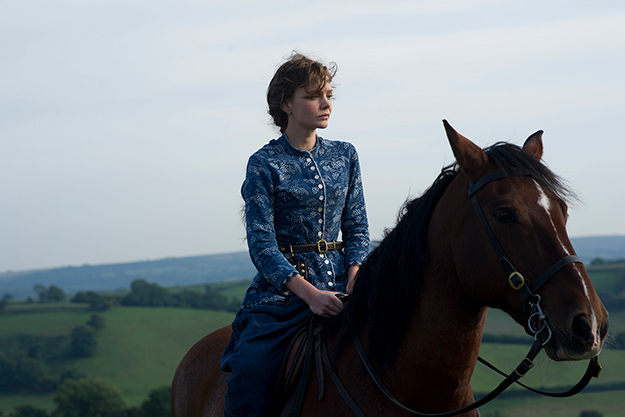During this interview held at the 2017 Camerimage Film Festival in Bydgoszcz, Poland, Christensen displayed a self-assurance that suggested someone who could go toe-to-toe with strong directing personalities such as Denzel Washington and Aaron Sorkin. As we turned the tape recorder on, she was still enthused from the previous night’s screening of Molly’s Game.
The Hunt Is there something about looking or the visual image that drew you to cinematography? Yes. I think it was even before I knew there was actually the job [of cinematographer]. My dad is a dairy farmer in Denmark, my mom is a hairdresser down the road, and we have no connection to the film industry at all. So from a little village in Denmark to New York or to Hollywood, there’s a long way. I was fascinated by images. [I would take] a little 35mm—at that time it was 35mm—camera and take images and I would make like eight or 10 photographs that were a story. So at 10 years old, even before I knew what it was, I was apparently fascinated by the fact that a number of images will tell a story. I told my dad, “Dad, I gotta take a photo of your dirty boots in the cow shit and then you gotta have my brother put on some business shoes.” And I took a photo of that, dirty boots and business shoes. This was a story that I remember clearly—the story of a businessman coming and this man losing his farm. I would tell those small stories of what I heard was going on—my parents had a hard time with the farm at that point. And at some point, you became interested in the moving image. My dad had a number of farms and he had to sell some, and he sold one property to this gentleman and his wife: he was a film composer, and his wife was a film director. And this man had horses, and I was a horse girl. We started riding, and he was maybe 40 years older than me, and he was saying “You know there’s actually a job where you can tell stories with images, you know that right?” It was a discovery! I didn’t know of cinematography. When you’re a kid, some kids will ask, “Where does milk come from?” Well, it comes from the cows! But I was like “Oh, God, somebody’s gotta make those images!” [Laughs] So when you become a cinematographer, you work with directors who also have a vision. How do you put together your desire to tell a story with someone else who has an opinion about how it should be told? Well, for example, I did one movie with Denzel Washington called Fences. And Denzel—like Aaron Sorkin with Molly’s Game—knew what the story was. Denzel had been on Broadway with this for a year with Viola Davis, and they’d been working on this piece for seven years. So he was very clear about what the vision was. But still, how to approach it? I remember sometimes I was like, there’s gotta be some handheld in here. I was fighting for those little handheld moments, whereas his personal style wasn’t necessarily handheld. Fences was a very gripping story to read and I read three or four times before I really understood everything, because it’s so complex. But then I started visualizing things, and now I know the script so well, I know what the ending is and now I see how you can build up the opening.
Fences You shot Far from the Madding Crowd, a period picture with a lot of sweep to it. And in that case, there’s a movie that already was made in the Sixties. Would you look at the film or stay away from it? I tend to look at everything and read everything I can—I think that there’s no limit to what research can give you. Then it’s your choice to say, “I can use this” or “this is not helpful to me.” With Far from the Madding Crowd, I read the novel and took a lot of notes from that. Thomas Hardy would spend 15 pages describing a view. So when you, as a cinematographer, are collaborating and expressing the story and you read the novel, you go, “Well, that’s an important view.” If he’s describing that tree and how the starry night was reflecting on the blah blah blah, that can’t just be a pretty view. The landscape was a character. When there’s a wide shot, I get inspired by the importance to him as a writer, growing up in Dorset—where we also were shooting the movie—and the love of this landscape. I feel we have to stay true to his desire to express the beauty of this place. It might not be a specific scene but it might be the importance of a wide shot. So I started studying wide shots. But what are you actually looking at? Is it a tree or is it the water or what is it? In the case of Fences, Denzel Washington seemed intent on keeping the integrity of the place. It seems like that’s a challenge for a cinematographer. Is that daunting or exciting, or…? Both. I think it was also a great challenge and there were days where it was like… could we have a desert somewhere? There were days where we were in this backyard, and the characters were static. They weren’t static at all in terms of performance and in terms of their journey or the words and the energy, but they might be sitting in a chair for a long time. But you have to develop this because it starts somewhere out here and it ends really deep in some story that the person’s telling, especially [Washington’s character] Troy, who is an entertainer in that movie. He entertains when he is with people. When he’s alone, he’s a different man. He’s fighting with the devil when he’s alone. He doesn’t like to be alone. He certainly becomes a smaller person when he’s alone. He feels smaller. And so would you try to get that with the camera, in terms of how to look at him? Yeah. When he was alone, we would go up a little bit. But with that movie everything is minimalistic. Camerawork these days, you can do anything. I’ll fly through that window anytime you want, and hop back in through the keyhole. So this little bit of change [shifting the camera up or down] was what the story needed and all that Denzel wanted too. He wanted to stay true to the play in a cinematic approach. And I have to say, he was very trusting. My advice was, “We need to make you feel smaller. Suddenly you’re lonely and we support that feeling by going up a little bit.” When he’s telling the stories and his arms are going, he’s a big guy and he’s too big for the space, [then you go] a little low and the arms are bigger and the trees are behind him, and you suddenly get that different feel of the same man.
Molly’s Game Can you apply that to how the camera might respond to a character in Molly’s Game? The main characters of a film always take you somewhere. I always try to connect the camera to that person and have a style, or support the feelings or the journey that this person is going through. Because that’s what cinematography is. It’s not just showing a person walking from A to B. We can all do that, you know, with our iPhones. But to express or tell the story of somebody walking. What does that person feel when he’s walking down the street? Is he escaping something or is he happily walking, excited, to his lover, leaving his wife? Like what is the story in that walk? So if it’s a heavy walk or if it’s a light walk, that’s a different image to me. All these choices are our jobs, you know, as cinematographers. Aaron [Sorkin] kept saying, there’s only once or twice in the movie where the audience needs to follow the poker game. The rest of the time Molly is in poker rooms, she’s dealing with the whole case. She’s often standing still in the corner, looking. So she isn’t moving and I think one of the things that I was discussing with Aaron was that we had to be careful that we don’t entertain just because we think people are gonna get bored—they weren’t, because of his energy in the writing and the voiceover. So I don’t need to force it with the images when she’s actually just standing still watching something. I think it would have been frustrating for people to hear a lot of words and then have a camera floating around. But it’s hard [during shooting] because we didn’t hear the voiceover, so basically it’s almost sort of a silent scene. So it felt like, is this going to be super boring? You have to imagine that the words [snaps fingers] are just [snaps] going. So it was about the cuts and the energy also of the editing. We had a lot of long lenses to compress the whole feeling of the room into her close-up. It was just a compression of the feeling of the room, shooting over the table without seeing [the game itself], really just feeling the smoke or the light or somebody’s hair. You see her seeing that, but we don’t necessarily see it, we just feel it. With Sorkin, everybody thinks this guy is a word-oriented artist. Did he bring visual ideas, or did you drive the conversation more? He is a master with words, he really is, and he understands pacing like nobody else. He’s not necessarily a technical guy—like knowing, “Oh, we’re gonna to put this lens on, if we move the camera I’m going to achieve that.” He was very trusting and very honest about it. In the first interview I had with him he said, you’ve gotta help me here, I know what we need, but I have no idea how to achieve it. In terms of physically suggesting a shot or visualizing it, he would trust me. But then he would still know if something was wrong—like there’s something here that needs to move, or he could describe a feeling and then I could say, “Okay, well then I think we need to do it this way.” And he was like, “that feels better.” It’s not like you sit down in preparation and go, “We’re gonna have this shot list and this storyboard and we’re going to do it this way.” You have to feel it on the day.
Far From the Madding Crowd Do you like storyboarding, or do you prefer this way that you’re talking about? I like a mix. I’m not necessarily a storyboard person. If you have an alien movie or a creature movie with a lot of VFX and you’re shooting something you can’t see, or if there’s a big action scene where four cars need to fly around in the air, it’s not about how I feel right now. It’s like, we’ve got to practically get four cars flying around in the air. It’s kind of helpful to have that drawn on paper so that the 40 people who know how to do this know what we’re trying to achieve. Would you like to be working in both film and digital as your career goes along? Would you miss film if you could never work in it again? Oh yeah. I want to work in both—each story is different and you want to do what’s right for the story. Sometimes digital media is just better for that project, practically or visually, whatever it is. And film has advantages too and disadvantages. Personally I love film. Most of the movies I’ve done have been shot on film. For some reason my brain can find any reason why that story seems to be helped by film. Shooting film is, to me, still more artistic because you leave something alone—you’re not perfect with every single image. [With digital], when you have these amazing monitors, everything is so brilliantly set up, that it’s almost like I don’t want to know exactly how black [the black will be]. I’ll go with my light and I know it’s going to fall into darkness. But I don’t want to discuss with everybody how black that dark is, you know. Leave that to me, let’s talk about the story. [With film] you take risks sometimes that I like and you will know in three days whether you were right or not. I feel sometimes it drives the set more because we don’t go in another room to look at a monitor, we look live at the people. We make the movie together on a film set like in the old days. I know maybe I’m just an up-and-comer, but maybe my brain is old-fashioned in the way that that’s how storytelling works better to me. That doesn’t mean I don’t like the digital media. I love the ALEXA cameras. And it’s fascinating, sometimes you need to be able to see this right now. But with some people in a room, and an intimate story going on—like Fences—film is a more interesting approach. It stays ambiguous somehow. You don’t want to know everything. Robert Horton is a writer based in Seattle.



